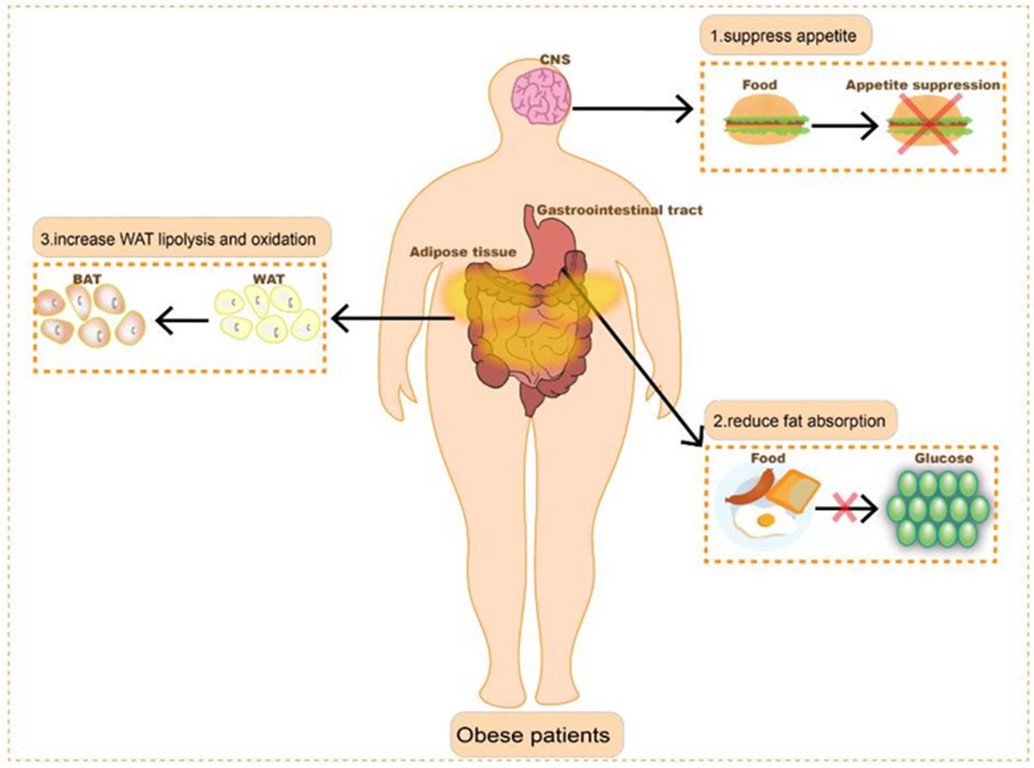Obesity, a complex and multifaceted disease, has reached pandemic proportions, posing significant challenges to global health. At Creative Biolabs, we are dedicated to advancing innovative solutions in the field of drug delivery. Our expertise in lipid-based drug delivery systems offers a promising avenue for enhancing the efficacy of obesity treatments. By leveraging our cutting-edge technology and extensive research capabilities, Creative Biolabs is committed to helping researchers and pharmaceutical companies overcome obstacles in developing effective therapies for obesity.
Obesity is classified as a chronic metabolic disease, characterized by excessive fat accumulation that presents risks for numerous comorbidities, including cardiovascular diseases, diabetes, and certain cancers.
 Fig. 1 Main mechanisms of action of anti-obesity drugs.1
Fig. 1 Main mechanisms of action of anti-obesity drugs.1
Adipose tissue (AT) plays a central role in obesity and serves as an ideal target for treatment. AT is not merely a passive fat storage organ but an active endocrine organ that secretes various adipokines influencing metabolism and energy balance. Targeting AT can address the root cause of obesity and its associated complications.
| Adipose Tissue Type | Composition | Distribution |
|---|---|---|
| White adipose tissue (WAT) | It is composed of adipocytes, collagen, lymphatic vessels, endothelial cells, smooth muscle cells, preadipocytes and mesenchymal stem cells. | It is widely distributed in the subcutaneous tissues of the body and around internal organs. |
| Brown adipose tissue (BAT) | It is composed of mature adipocytes, preadipocytes, adipose-derived stem cells, endothelial cells, hematopoietic cells, etc. | It exists in the interscapular, axillary and cervical regions, as well as around organs such as the kidneys and aorta. |
At Creative Biolabs, we understand that obesity treatment faces significant challenges, including poor bioavailability of anti-obesity drugs, non-targeted delivery, and rapid metabolism. The innovative lipid-based drug delivery system we have launched (such as liposomes, solid lipid nanoparticles and nanostructured lipid carriers, etc.) can overcome these challenges and achieve effective weight loss results. We're really proud of what they can do to help overcome those old treatment limitations and make a real difference in obesity treatment.
Creative Biolabs' lipid-based drug delivery systems offer innovative solutions for precise targeting of AT in obesity treatment. Our advanced delivery systems can be engineered with a variety of targeting moieties, including peptides, aptamer, polymer, and antibodies, to ensure accurate delivery of anti-obesity drugs directly to WAT/BAT.
Creative Biolabs excels in developing high-quality lipid-based drug delivery systems for a variety of anti-obesity drugs, accelerating your research progress. Our expertise covers multiple categories of compounds:
| Drug Category | Anti-Obesity Drugs | Mechanism | Inquiry |
|---|---|---|---|
| Polyphenols | Resveratrol | Promote fatty acid oxidation and browning of WAT. | Inquiry |
| Catechins |
Inhibits lipogenic enzymes; Promote the growth of beneficial intestinal bacteria; Enhance thermogenesis and fat oxidation. |
Inquiry | |
| Quercetin |
Inhibit lipid accumulation; Down-regulate pro-inflammatory cytokines. |
Inquiry | |
| Curcumin | Inhibit fat production and promote fat breakdown. | Inquiry | |
| Hesperidin |
Reduce lipid accumulation; Promote fat oxidation. |
Inquiry | |
| Apigenin |
Inhibit fat formation Promote mitochondrial activity. |
Inquiry | |
| Alkaloids | Berberine |
Inhibit fat production; Reduce lipid accumulation in the liver. |
Inquiry |
| Ephedrine |
Increase basal metabolic rate and fat breakdown; Suppress appetite. |
Inquiry | |
| Caffeine |
Promote fat oxidation and energy consumption; Suppress appetite. |
Inquiry | |
| Capsaicin |
Promote fat oxidation; Suppress appetite. |
Inquiry | |
| Nicotine |
Promote fat breakdown; Suppress appetite. |
Inquiry | |
| Piperine | Inhibit adipocyte differentiation. | Inquiry | |
| Reserpine | Suppress appetite. | Inquiry | |
| Terpenoids | Forskolin | Promote fat breakdown. | Inquiry |
| Ginsenoside Rb1 |
Regulate fat production; Increase energy consumption; Improve insulin sensitivity. |
Inquiry | |
| Limonene |
Regulate lipid metabolism; Increase the oxidation of fatty acids; Reduce fat accumulation. |
Inquiry | |
| Carnosic acid |
Promote fat breakdown; Reduce oxidative stress; Inhibit adipocyte differentiation. |
Inquiry | |
| Humulone | Inhibit fat generation. | Inquiry | |
| Betulinic acid |
Induces apoptosis in pre-adipocytes; Inhibits differentiation into mature adipocytes. |
Inquiry | |
| Ursolic acid |
Inhibit fat deposition; Enhance the activity of brown fat. |
Inquiry | |
| Saponins | Dioscin |
Inhibit α-glucosidase; Enhance glucose uptake; Regulate insulin signals. |
Inquiry |
| Astragaloside IV | Regulates oxidative stress. | Inquiry | |
| Saikosaponin A | Enhance insulin sensitivity. | Inquiry | |
| Aescin | Improve glucose metabolism. | Inquiry | |
| Other | Gingerol |
Increase energy consumption; Reduce fat accumulation |
Inquiry |
| Silymarin |
Reduce oxidative stress; Regulate lipid metabolism; Improve insulin sensitivity. |
Inquiry | |
| Astaxanthin |
Reduce oxidative stress; Inhibit inflammation; Improve lipid metabolism. |
Inquiry |
Leveraging our advanced technology, we specialize in functionalized delivery systems for targeted obesity treatment:
Post successful laboratory development, our robust large-scale production infrastructure ensures consistent and stable manufacturing of lipid-based drug delivery systems for obesity research, meeting the demands of extensive preclinical studies.
Creative Biolabs' lipid-based drug delivery systems offer a powerful tool for obesity treatment research. Our innovative solutions address challenges such as poor bioavailability and non-targeted delivery, helping you accelerate drug development and enhance research outcomes. Ready to advance your obesity treatment research? Contact us today!
Reference
 For Research Use Only. Not For Clinical Use
For Research Use Only. Not For Clinical UseApplications
Online Inquiry

